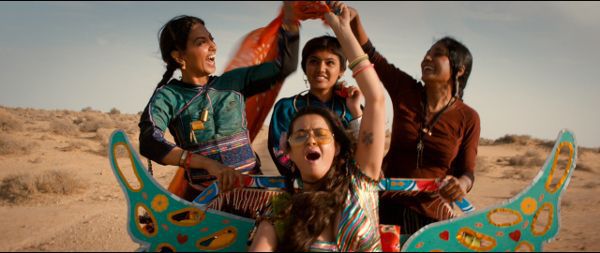Eye For Film >> Movies >> Parched (2015) Film Review
Parched
Reviewed by: Amber Wilkinson

Female freedom runs like gusts of wind through hair in Leena Yadav's Parched - refreshing and vital yet easily stilled. Patriarchy and, to an extent the women themselves, form a shield against it in a bid to conform to the airless but familiar confines of tradition.
Exploring similar territory to Elite Zexer's Sand Storm - although with a more soapy and fairy tale vibe - Yadav focuses on the women in a small rural community in India. Rani (Tannishtha Chatterjee) is, despite her unusual position as the head of a household after the death of her husband, a follower of tradition. Her life revolves around her son Gulab (Riddhi Sen), who, at 17, has been steeped in entitlement so long he has turned sour, showing little regard for his mother or the prospect of a new, young bride, beyond their capacity to entertain him when he chooses.
When it transpires his child bride Janaki (Lehar Khan) has had her hair cut off due to lice, his rejection and vitriol become acute, with Rani mirroring his displeasure despite having experienced a similar marriage when she was a girl. The echoes of Janaki's plight also ring through the life of Rani's friend Lajjo (Radhika Apte), who is regularly beaten by her drunk husband and who carries her own badge of shame - the apparent inability to bear children. Freedom of spirit is represented by their wild friend Bijli (Surveen Chawla), an exotic dancer and prostitute who believes in seizing life by the scruff of the neck but who is, in her own way, entirely confined by men's expectations and ownership of her.
Yadav weaves a complex picture of the women's village, showing that even men who are progressive - such as local businessman Kishan (Sumeet Vyas), who helps the women earn cash through sewing and who has taken what locals consider to be a 'foreign' bride - are treated with distrust by both sexes. It requires tricky acrobatics to keep all the stories running along together but Yadav does an excellent job of laying out this complex landscape, so that the details coalesce into a modern fable. She also keeps a mainstream audience in mind, hinting at the horrors suffered by the women but maintaining an emphasis on their friendship and solidarity. She may not wallow in details but she makes sure we're aware of the women's harsh reality. Despite its strong sense of place, with cinematographer Russell Carpenter using the arid landscape and night-time glowing half-light to give the film harshness and vibrancy by turns - the women's experiences resonate beyond India. We in the West may, on the whole, not have arranged marriages, but there are still plenty who suffer domestic violence while their friends, though supportive, struggle to help them escape it.
The march of technology - including the village women's petition to their men-folk to get a television and Rani's mobile phone - hint that trying to keep women in 'splendid' and illiterate isolation is no more sensible than trying to stop leaves rustling in a breeze. But it is the women themselves who are the real catalyst for change, finding it in themselves to remember a time when they were like Janaki and consider another future. The four women at the film's heart have a simmering chemistry and though the film's conclusion is somewhat hastily worked compared to the intricate development that has gone before, the hopeful resolution feels in keeping with the film's fable elements, reminding us that happy endings, while not always probable, are still possible.
Reviewed on: 18 Jun 2016















